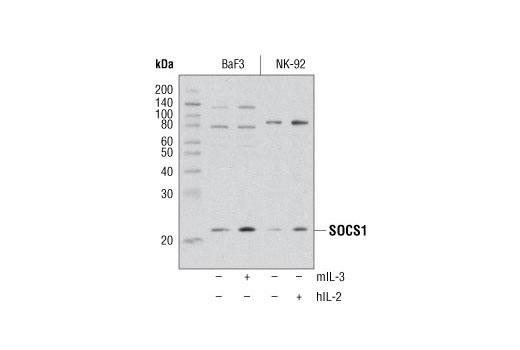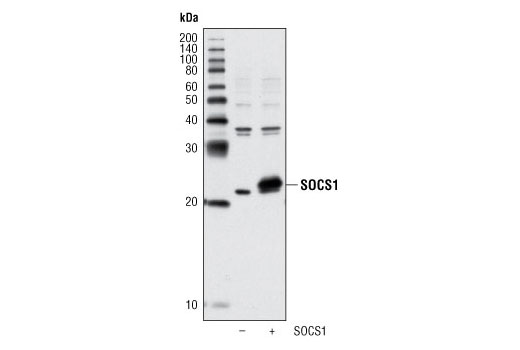WB
H M R Mk
Endogenous
23
Rabbit
#O15524
8651
Product Information
Product Usage Information
| Application | Dilution |
|---|---|
| Western Blotting | 1:1000 |
Storage
Specificity / Sensitivity
Species Reactivity:
Human, Mouse, Rat, Monkey
Species predicted to react based on 100% sequence homology
The antigen sequence used to produce this antibody shares
100% sequence homology with the species listed here, but
reactivity has not been tested or confirmed to work by CST.
Use of this product with these species is not covered under
our
Product Performance Guarantee.
Dog
Source / Purification
Polyclonal antibodies are produced by immunizing animals with a synthetic peptide corresponding to residues surrounding Ala156 of human SOCS1. Antibodies were purified by protein A and peptide affinity chromatography.
Background
The suppressor of cytokine signaling (SOCS) family members are negative regulators of cytokine signal transduction that inhibit the Jak/Stat pathway (1-3). The SOCS family consists of at least 8 members including the originally identified cytokine-inducible SH2-containing protein (CIS1), as well as SOCS1-7. Each SOCS family member contains a central SH2 domain and a conserved carboxy-terminal motif designated as the SOCS box. These proteins are important regulators of cytokine signaling, proliferation, differentiation, and immune responses.
SOCS1 (suppressor of cytokine signaling 1), also known as JAB (Janus Kinase binding protein), SSI-1 (Stat-induced Stat inhibitor-1), and TIP3 (Tec-interacting protein 3) (4-7), is a cytokine-regulated SOCS family member that directly inhibits Jak family members through interaction within their kinase activation loop. In addition to inhibiting Jak/Stat signaling, SOCS1 can also negatively regulate Toll-like receptors that contribute to innate immunity (8,9). The SOCS box of SOCS1 can trigger ubiquitin-mediated degradation of proteins within and outside of the Jak/Stat pathway (10,11). The highest expression of SOCS1 is seen in the thymus and spleen and it plays a critical role in T-cell activation and lymphocyte differentiation (4,12). SOCS1 also functions as a tumor suppressor protein by inhibiting hematopoietic oncogenes (13,14).
- Alexander, W.S. et al. (1999) J Leukoc Biol 66, 588-92.
- Chen, X.P. et al. (2000) Immunity 13, 287-90.
- Hilton, D.J. et al. (1998) Proc Natl Acad Sci USA 95, 114-9.
- Starr, R. et al. (1997) Nature 387, 917-21.
- Endo, T.A. et al. (1997) Nature 387, 921-4.
- Naka, T. et al. (1997) Nature 387, 924-9.
- Ohya, K. et al. (1997) J Biol Chem 272, 27178-82.
- Kinjyo, I. et al. (2002) Immunity 17, 583-91.
- Davey, G.M. et al. (2006) Tissue Antigens 67, 1-9.
- Kamizono, S. et al. (2001) J Biol Chem 276, 12530-8.
- Rui, L. et al. (2002) J Biol Chem 277, 42394-8.
- Marine, J.C. et al. (1999) Cell 98, 609-16.
- De Sepulveda, P. et al. (1999) EMBO J 18, 904-15.
- Rottapel, R. et al. (2002) Oncogene 21, 4351-62.
Species Reactivity
Species reactivity is determined by testing in at least one approved application (e.g., western blot).
Western Blot Buffer
IMPORTANT: For western blots, incubate membrane with diluted primary antibody in 5% w/v BSA, 1X TBS, 0.1% Tween® 20 at 4°C with gentle shaking, overnight.
Applications Key
WB: Western Blotting
Cross-Reactivity Key
H: human M: mouse R: rat Hm: hamster Mk: monkey Vir: virus Mi: mink C: chicken Dm: D. melanogaster X: Xenopus Z: zebrafish B: bovine Dg: dog Pg: pig Sc: S. cerevisiae Ce: C. elegans Hr: horse GP: Guinea Pig Rab: rabbit All: all species expected
Trademarks and Patents
Limited Uses
Except as otherwise expressly agreed in a writing signed by a legally authorized representative of CST, the following terms apply to Products provided by CST, its affiliates or its distributors. Any Customer's terms and conditions that are in addition to, or different from, those contained herein, unless separately accepted in writing by a legally authorized representative of CST, are rejected and are of no force or effect.
Products are labeled with For Research Use Only or a similar labeling statement and have not been approved, cleared, or licensed by the FDA or other regulatory foreign or domestic entity, for any purpose. Customer shall not use any Product for any diagnostic or therapeutic purpose, or otherwise in any manner that conflicts with its labeling statement. Products sold or licensed by CST are provided for Customer as the end-user and solely for research and development uses. Any use of Product for diagnostic, prophylactic or therapeutic purposes, or any purchase of Product for resale (alone or as a component) or other commercial purpose, requires a separate license from CST. Customer shall (a) not sell, license, loan, donate or otherwise transfer or make available any Product to any third party, whether alone or in combination with other materials, or use the Products to manufacture any commercial products, (b) not copy, modify, reverse engineer, decompile, disassemble or otherwise attempt to discover the underlying structure or technology of the Products, or use the Products for the purpose of developing any products or services that would compete with CST products or services, (c) not alter or remove from the Products any trademarks, trade names, logos, patent or copyright notices or markings, (d) use the Products solely in accordance with CST Product Terms of Sale and any applicable documentation, and (e) comply with any license, terms of service or similar agreement with respect to any third party products or services used by Customer in connection with the Products.

